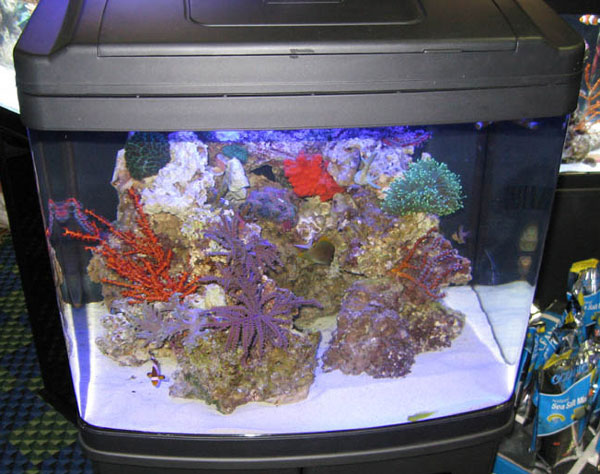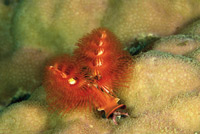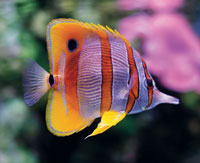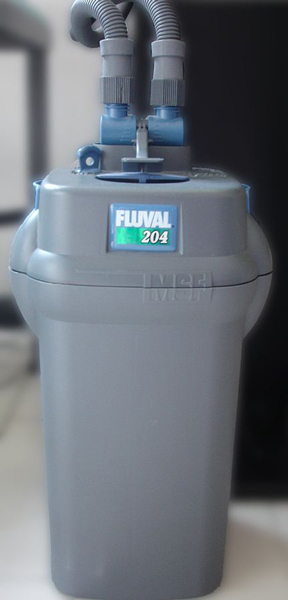

Q. I have a 14-gallon nano cube that I set up about one month ago. My mushroom corals all died and my toadstool leather coral appears to be withering away. I lost most of my snails and all of my hermit crabs and my zoo polyps are not looking very good. The fish in the tank all look healthy and are as follows:
I have several cleaner shrimp and a coral banded shrimp as well and they all appear healthy. My nitrates were over 50 ppm but with daily water changes they are down to 20 ppm. I don’t detect any ammonia when I do a test. What can I do to get this aquarium back under control? My pH is totally out of control and I am using a ton of buffer solution to keep it above 8.0. I have 16 pounds of live sand and 17 pounds of live rock. My local fish store has advised me on everything with this aquarium. Should I stop listening to them?
Kari Elliott
Maryland
A. Interestingly, small marine aquariums are far harder to keep than larger marine systems. Whenever you are dealing with a very small amount of water any fluctuation comes quickly and has a more pronounced effect on the aquarium system. Also, marine systems take a considerable amount of time to mature. When we consider that your aquarium has 17 pounds of live rock and another 16 pounds of live sand you likely only have 8 or 9 gallons of water in the aquarium. Considering this, any amount of evaporation will likely cause a very severe salinity change and could affect every value in your tank, including your pH. As far as stocking is concerned, you may have gotten a little ahead of yourself.
Before keeping any corals, several values need to be established and kept in check. The first is your pH which can walk hand-in-hand with alkalinity. The pH in a marine system should be about 8.2. Considering the amount of live rock and live sand that you have in your aquarium, you shouldn’t be having serious pH problems. To successfully keep corals you need to have a stable pH and then work on your calcium and alkalinity values. Your alkalinity should test out at 12 dKH and your calcium should be around 350 to 400 ppm. Considering the severe fluctuations you are having with pH, it is highly likely that all of these values are skewed, thus causing serious imbalance in the system.
Nitrate levels at 50 ppm are very high. The death of so many snails, crabs and corals has probably raised the nutrient level in your aquarium and accounts for the high nitrate readings. While I am a proponent of frequent water changes, daily water changes on an immature tank could be making these compounding problems worse. While the water changes are removing a lot of excessive nitrate they are making it tough for your bacterial filter to get a foothold in the aquarium.
When there are so many problems with a tank it is sometimes better to take two steps back rather then one step forward. I would see if a fish outlet would take your surviving corals and give you store credit for them. While your tank can support the number and species of fish you have quoted, adding them over the course of several months (to one year) is a far better approach when working with an immature tank. If they are eating and appear healthy then they are probably all right to leave be.
I would recommend removing the coral banded shrimp from the aquarium. These shrimp grow large and could easily make a meal out of several of the fish species you are keeping. Once the corals are removed you can begin the process of repairing some of the issues that are present. The first and most prudent order of business is stabilizing your pH. Using buffers can work for short-term repairs but is really like applying a Band-Aid to a wound that needs stitches. Your tank’s density should be around 1.025 so make sure that it is up to par before doing much with the pH. Monitoring evaporation and not over-topping off the tank can also help control fluctuation. Once your pH has stabilized you can monitor your calcium and alkalinity values and begin using a buffer, if needed.
Once these all take shape and the tank’s water parameters are holding you can begin looking at keeping some hardy corals. Many local fish stores are far better at selling aquarium livestock than advising aquarists on how to successfully keep a marine aquarium. The definition of "success” among marine aquarists varies and what one aquarist may deem failure another sees as a positive result. In some overseas countries it is not uncommon to constantly replace corals as they die. In the United States, as far as reef tanks are concerned, success is often measured by longevity of keeping animals alive and healthy.
My recommendation at this point is to invest in the most important reefkeeping tool of all, which is a good book. Also, a membership to one of the plethora of reef aquarium forums, like ours here at FishChannel.com, may be of help as well.
 Aiptasia
Q. I have Aiptasia all over my aquarium and have been
Aiptasia
Q. I have Aiptasia all over my aquarium and have been
 Aiptasia Anemone
Aiptasia Anemone
 Red Worms
Q. I’ve seen advertisements for red worms as a food for fish
Red Worms
Q. I’ve seen advertisements for red worms as a food for fish
 Useful Idea For Stronger Nutrition And Wellness
It truly does show when you take time to create a proper no
Useful Idea For Stronger Nutrition And Wellness
It truly does show when you take time to create a proper no
 Canister Filters
In this article we will deal with a type of filter that many
Canister Filters
In this article we will deal with a type of filter that many
Copyright © 2005-2016 Pet Information All Rights Reserved
Contact us: www162date@outlook.com